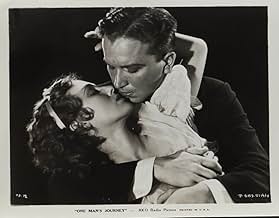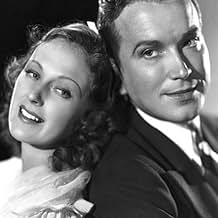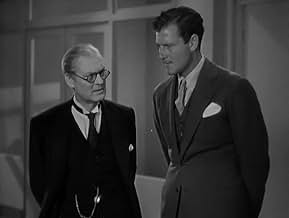Ajouter une intrigue dans votre langueWidower Dr. Watt moves to a small town, raising son Jimmy and abandoned Letty. Despite aspirations for research, epidemic, family needs hinder his goals. Years later, he realizes his life wa... Tout lireWidower Dr. Watt moves to a small town, raising son Jimmy and abandoned Letty. Despite aspirations for research, epidemic, family needs hinder his goals. Years later, he realizes his life wasn't a failure.Widower Dr. Watt moves to a small town, raising son Jimmy and abandoned Letty. Despite aspirations for research, epidemic, family needs hinder his goals. Years later, he realizes his life wasn't a failure.
- Réalisation
- Scénario
- Casting principal
- Récompenses
- 3 victoires au total
Samuel S. Hinds
- Dr. Babcock
- (as Sam Hinds)
Frank Ball
- Townsman
- (non crédité)
Dorothy Gray
- Letty's Daughter
- (non crédité)
John Ince
- Dr. James Carson
- (non crédité)
Lloyd Ingraham
- Townsman at Farewell Meeting
- (non crédité)
Dave O'Brien
- Dance Extra
- (non crédité)
Avis à la une
Lionel Barrymore gave a memorably restrained performance in this 1933 film. It stands as a precursor to films such as 1959's "The Last Angry Man" with Paul Muni.
The setting takes place in rural America circa 1910. Having lost his wife in childbirth, Barrymore returns to his roots only to lose his first patient there as well to child-birth. The embittered husband is ready to take the baby to the poor house but Barrymore takes the little baby girl in along with his young son. Just on the girl's 4th birthday, the father returns and seems much reformed. Barrymore gives the girl, Letty, back to him. Letty maintains a father-like relationship with Barrymore through the years.
As the years pass, Barrymore wins the hearts of the town with his dedication and free services for the impoverished.
He lets opportunities pass which could have gotten him out of the town. Some how we know this from the George Bailey effect of 1946's "It's A Wonderful Life." Like George Bailey, this doctor is going nowhere.
May Robson costars as a beloved housekeeper who enters the Barrymore home at precisely the right time.
This is a nicely done heartwarming story of rural America from 1910 through 1933.
The setting takes place in rural America circa 1910. Having lost his wife in childbirth, Barrymore returns to his roots only to lose his first patient there as well to child-birth. The embittered husband is ready to take the baby to the poor house but Barrymore takes the little baby girl in along with his young son. Just on the girl's 4th birthday, the father returns and seems much reformed. Barrymore gives the girl, Letty, back to him. Letty maintains a father-like relationship with Barrymore through the years.
As the years pass, Barrymore wins the hearts of the town with his dedication and free services for the impoverished.
He lets opportunities pass which could have gotten him out of the town. Some how we know this from the George Bailey effect of 1946's "It's A Wonderful Life." Like George Bailey, this doctor is going nowhere.
May Robson costars as a beloved housekeeper who enters the Barrymore home at precisely the right time.
This is a nicely done heartwarming story of rural America from 1910 through 1933.
Lionel Barrymore got to play a nice guy for a change in this sentimental drama. In an unusually subdued performance, Barrymore plays a widowed family doctor starting a new life with his young son in a small town. The locals are leery of the outsider and the few cases that come his way are paid for with potatoes and eggs. When one of his patients dies in childbirth, the angry husband wants nothing to do with his infant daughter, so the kind doctor takes her in. Soon feisty May Robson comes aboard as a volunteer housekeeper. The story fast-forwards twenty years to find the son (Joel McCrea) a hotshot Type-A doctor with little time for his beautiful and long-suffering fiancée Frances Dee. At the end of course, everyone realizes how fortunate they really are. It was nice to see the luminescent Miss Dee on the big screen only two days before she died at age 94. Screened at Cinefest in Syracuse New York, March 2004.
8tavm
Just discovered on Mark Evanier's blog that Turner Classic Movies-on their blog-are running a feature every month. One Man's Journey is for June. This just-rediscovered RKO release from 1933 stars Lionel Barrymore as Dr. Eli Watt, a widowed man with 6-year old son Jimmy (Buster Phelps) coming back to his old country roots. Since many of the townspeople are nearly poor, Dr. Watt accepts payment in potatoes or other foods. That's what the husband of his first patient offers to him. This husband-a McGinnis (David Landau)-gets some good news and bad news. Good: He has a healthy baby girl. Bad: The mother died giving birth. McGinnis wants no part of his girl's life and threatens to kill Eli. For four years, Eli helps raise the girl with Jimmy, a dog, and their housekeeper Sarah (May Robson). Then McGinnis, having rehabilitated himself, wants her back. We then flash-forward about 15 or so years with that daughter Letty (Dorothy Jordan) grown up and helping Dr. Watt care for several children with smallpox. Son Jimmy (now played by Joel McCrea) is becoming a doctor himself. I'll stop here and mention some other players: James Bush as Bill Radford-Letty's eventual husband, Frances Dee as Joan Stockton-Jimmy's fiancée (and later McCrea's real-life wife), Dorothy Gray as Letty's daughter who has a heart-tugging scene with Barrymore when he's carrying her, and Samuel S. Hinds (or Sam Hinds as he's credited here) as Dr. Roger Babcock who pays Eli a very high compliment at the end that makes a marked contrast to me when I remember their later roles on It's a Wonderful Life as-respectively-Peter Bailey and Henry F. Potter-fighting over foreclosures in front of Bailey's son George. All of them give wonderful performances with Mr. Lionel Barrymore at his most heartwarming throughout. There's also some stirring yet underplayed musical scoring by Max Steiner. In summation, One Man's Journey is one of those "they-don't-make-them-like-they-used-to" pictures that makes you wish they still did!
Soap opera spanning from the horse and buggy through to the current day, 1933, following the career of Eli Watt (played by Lionel Barrymore), a widower who has come back to his rural hometown where he fixes up "the old place" and sets himself up as town doctor (and mostly gets paid by the locals with sacks of potatoes). On his very first doctoring job, a mother giving birth dies, the angry, heartbroken dad wants nothing to do with his new baby daughter, so Doctor takes the baby home to raise along with his own young son. After four years the angry dad now regrets his decision and takes the girl back - then the years progress as Eli's son grows up and is training to be a doctor himself, and Eli becomes a hero during a local smallpox epidemic.
This is a warmhearted, interesting film boosted up by a very well done performance given by Lionel Barrymore who plays the kindly doctor with a lot of charm. May Robson is appealing here playing a plucky local woman who comes to live with the doctor and help care for the household and baby alike. Joel McCrea also appears in this as the doctor's son - he gives a nice performance but isn't really given that much to do. All in all, a quite entertaining film.
This is a warmhearted, interesting film boosted up by a very well done performance given by Lionel Barrymore who plays the kindly doctor with a lot of charm. May Robson is appealing here playing a plucky local woman who comes to live with the doctor and help care for the household and baby alike. Joel McCrea also appears in this as the doctor's son - he gives a nice performance but isn't really given that much to do. All in all, a quite entertaining film.
This is one of the "lost but found" films shown on TCM on 4/4/07. Apparently this and two other films shown that night were held out of public release due to litigation concerning royalties and now the powers that be at Turner Classic Movies have taken care of the licensing issues. Of the three films shown that night, none of them were great treasures but all three were excellent--very solid examples of the type of films RKO made during the era. Normally, when you think of RKO in 1933, you think KING KONG or Astaire and Rogers as a team, but there were other good films that might rank just below them in quality and entertainment.
This film is rather reminiscent of several other doctor dramas from the era (such as THE CITADEL and ARROWSMITH) where the doctor's nobility and sacrifice are celebrated. A younger Lionel Barrymore (sporting a dark doo thanks to hair dye) comes to a rural area to set up a medical practice. However, at first, he is unsuccessful and only begins to get patients when he agrees to use the barter system. Because of this, he is constantly in financial straits, but because he is so noble and decent, he doesn't give up and is eventually accepted and loved by the community. While all this could have been VERY syrupy, thanks to good writing and a terrific performance by Barrymore it is not.
There is certainly a lot more to the movie than this--including an excellent (as usual) performance by May Robson and an early performance by Joel McCrea. See this film and see a "small" film that really packs an excellent punch.
This film is rather reminiscent of several other doctor dramas from the era (such as THE CITADEL and ARROWSMITH) where the doctor's nobility and sacrifice are celebrated. A younger Lionel Barrymore (sporting a dark doo thanks to hair dye) comes to a rural area to set up a medical practice. However, at first, he is unsuccessful and only begins to get patients when he agrees to use the barter system. Because of this, he is constantly in financial straits, but because he is so noble and decent, he doesn't give up and is eventually accepted and loved by the community. While all this could have been VERY syrupy, thanks to good writing and a terrific performance by Barrymore it is not.
There is certainly a lot more to the movie than this--including an excellent (as usual) performance by May Robson and an early performance by Joel McCrea. See this film and see a "small" film that really packs an excellent punch.
Le saviez-vous
- AnecdotesMerian C. Cooper had accused RKO of not paying him all the money contractually due for six RKO films he produced in the 1930s. In 1946, a settlement was reached, giving Cooper complete ownership of the RKO titles: Idylle sous les toits (1933) with Ginger Rogers, La femme aux gardénias (1933) with Ann Harding and William Powell, The Right to Romance (1933) with Ann Harding and Robert Young, One Man's Journey (1933) with Lionel Barrymore, Living on Love (1937) and A Man to Remember (1938).
In 2006, Turner Classic Movies, which had acquired the rights to the six films after extensive legal negotiations, broadcast them on TCM in April 2007, their first full public exhibition in over 70 years. TCM, in association with the Library of Congress and the Brigham Young University Motion Picture Archive, had searched many film archives throughout the world to find copies of the films in order to create new 35mm prints.
- GaffesAs Dr. Watt leaves the McGinnis house, the shadows of the trees fall clearly on the "sky" cyclorama.
- ConnexionsFeatured in TCM: Twenty Classic Moments (2014)
- Bandes originalesDown By the Old Mill Stream
(1910) (uncredited)
Written by Tell Taylor
In the score during the opening credits and at the end
Meilleurs choix
Connectez-vous pour évaluer et suivre la liste de favoris afin de recevoir des recommandations personnalisées
Détails
- Date de sortie
- Pays d’origine
- Langue
- Aussi connu sous le nom de
- El viajero solitario
- Lieux de tournage
- Société de production
- Voir plus de crédits d'entreprise sur IMDbPro
- Durée1 heure 12 minutes
- Couleur
- Rapport de forme
- 1.37 : 1
Contribuer à cette page
Suggérer une modification ou ajouter du contenu manquant

Lacune principale
By what name was One Man's Journey (1933) officially released in Canada in English?
Répondre




































